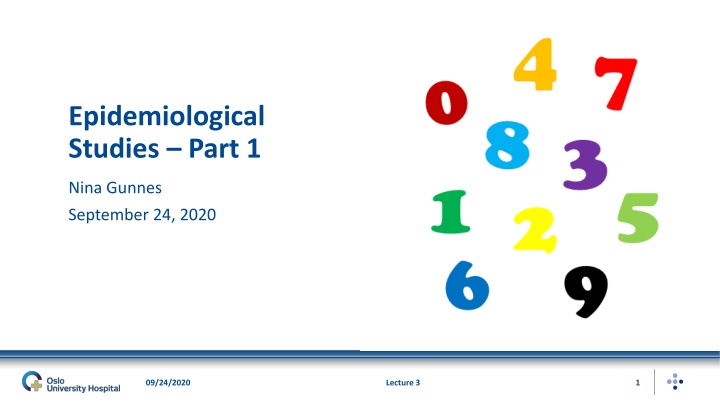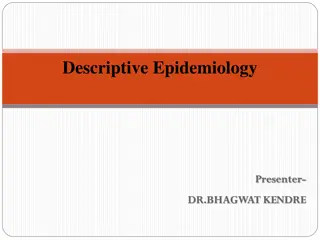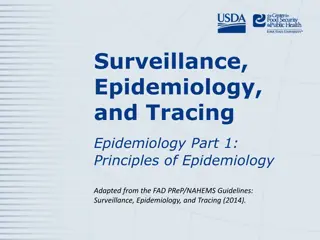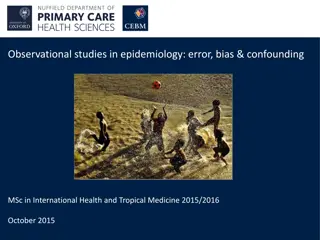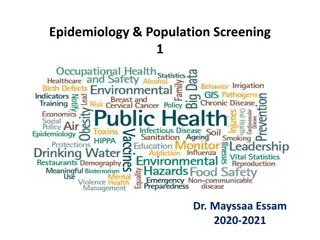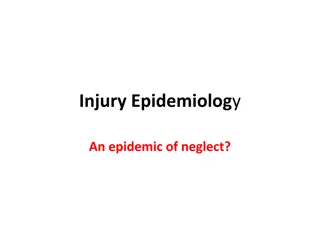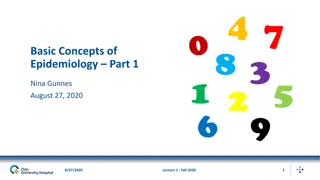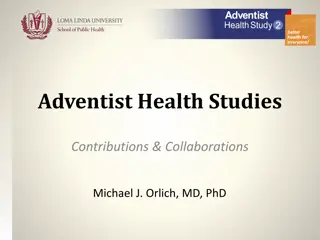Overview of Ecological Studies in Epidemiology
Ecological studies in epidemiology involve studying groups of individuals at a population level to examine the correlation between exposure and disease occurrence. While cost-effective and useful for generating hypotheses, ecological studies have limitations, such as the inability to control for confounding variables at the individual level. They provide insights that must be verified using other study designs. An example involving the correlation between environmental factors, fat consumption, and cancer rates illustrates the complexities of drawing concrete conclusions from ecological studies.
Download Presentation

Please find below an Image/Link to download the presentation.
The content on the website is provided AS IS for your information and personal use only. It may not be sold, licensed, or shared on other websites without obtaining consent from the author.If you encounter any issues during the download, it is possible that the publisher has removed the file from their server.
You are allowed to download the files provided on this website for personal or commercial use, subject to the condition that they are used lawfully. All files are the property of their respective owners.
The content on the website is provided AS IS for your information and personal use only. It may not be sold, licensed, or shared on other websites without obtaining consent from the author.
E N D
Presentation Transcript
Epidemiological Studies Part 1 Nina Gunnes September 24, 2020 09/24/2020 Lecture 3 1
Types of epidemiological studies Two main types of epidemiological studies Observational studies Experimental studies Four types of observational studies Ecological studies Cross-sectional studies Case-control studies Cohort studies 09/24/2020 Lecture 3 2
Ecological studies Study unit at population (or community level) Groups of individuals instead of individuals Correlation study of different populations being a typical example Comparing occurrence of disease with mean exposure Several advantages Inexpensive Exposure at population level more stable than at individual level Potentially big contrasts in exposure between populations 09/24/2020 Lecture 3 3
Ecological studies, cont. Great weaknesses Exposure and disease measured at group level (exposed becoming diseased?) Not possible to control for confounding at individual level Cannot alone establish association between exposure and disease Providing important hypotheses Must be verified by using other study designs 09/24/2020 Lecture 3 4
Example 10.5 in Aalen et al. (2006) 09/24/2020 Lecture 3 5
Example 10.5 in Aalen et al. (2006), cont. Correlation study of environmental factors and cancer Incidence rates for 27 cancers in 23 countries Mortality rates for 14 cancers in 32 countries Pointers to environmental factors in the etiology of cancer Per caput daily total fat consumption and incidence of breast cancer Pearson s correlation coefficient: ? = 0.79 Difference in incidence not necessarily due to difference in fat consumption Confounding variables related to diet and lifestyle of great importance 09/24/2020 Lecture 3 6
Example 10.5 in Aalen et al. (2006), cont. Per caput daily meat consumption and incidence of colon cancer Pearson s correlation coefficient, men: ? = 0.85 Pearson s correlation coefficient, women: ? = 0.89 First indications of diet impact on cancer risk from ecological studies Several case-control studies and cohort studies also conducted Exploring association between fat consumption and risk of breast cancer Total fat consumption not considered important risk factor for breast cancer 09/24/2020 Lecture 3 7
Cross-sectional studies Measuring prevalence of disease or risk factor at a particular time Some obvious benefits Relatively quick, inexpensive, and easy to understand Can be standardized Possible to examine many variables in the same study Several weaknesses Cannot estimate risk of disease Can only establish association between exposure and disease not causality 09/24/2020 Lecture 3 8
Cross-sectional studies, cont. Important findings must be checked by using other study designs Observed changes over time by repeated cross-sectional studies May reflect real time trends Findings due to differences between participants at different times? 09/24/2020 Lecture 3 9
Example 10.6 in Aalen et al. (2006) 09/24/2020 Lecture 3 10
Example 10.6 in Aalen et al. (2006), cont. Repeated cross-sectional studies on sexual habits (1987 2002) Norwegian Institute of Public Health https://www.fhi.no/publ/eldre/rapport-fra-seksualvane-undersokels/ Obtaining knowledge about sexual habits of the population Understanding, predicting, and preventing sexually transmitted diseases Preventing unwanted pregnancies Surveys conducted at 5-year intervals Four questionnaires in 1987, 1992, 1997, and 2002 09/24/2020 Lecture 3 11
Example 10.6 in Aalen et al. (2006), cont. Questionnaire in 2002 Sent out to 10,000 subjects aged 18 49 years Response rate of 36% 95.6% of males and 96.8% of females having had sexual intercourse Main conclusions on time trends based on all questionnaires People more sexually active Decreased age of sexual debut Increased proportion of subjects with homosexual experience 09/24/2020 Lecture 3 12
Case-control studies Based on groups of subjects with and without disease Cases Controls Controls representing the base population of the cases Exploring whether exposure in the two groups differ Registration of exposure for each subject Retrospective Going back in time to obtain information about exposure 09/24/2020 Lecture 3 13
Case-control studies, cont. Great advantages Easy, quick, and inexpensive Well suited for rare diseases Several exposures possible Drop-out avoided Exposures registered after diagnosis of disease Subjects more or less likely to recall prior exposure depending on outcome? Potential recall bias! 09/24/2020 Lecture 3 14
Case-control studies, cont. Investigator knowing disease status of the subjects More intense interrogation of cases regarding exposure? Some further disadvantages Unsuited for rare exposures Restricted to only one disease Estimation of disease occurrence (prevalence and incidence) not possible Odds ratio as effect measure Interpreted as relative risk for rare diseases 09/24/2020 Lecture 3 15
Example 10.7 in Aalen et al. (2006) 09/24/2020 Lecture 3 16
Example 10.7 in Aalen et al. (2006), cont. Danish case-control study of malignant melanoma Cases of newly diagnosed patients aged 20 79 years Controls in the same age group and from the same geographical area Investigating risk factors of malignant melanoma Cases and controls interviewed about exposures Number of raised nevi (moles) on the arms Constructing a two-by-two table 09/24/2020 Lecture 3 17
Example 10.7 in Aalen et al. (2006), cont. Number of raised nevi on the arms 5+ 0 Cases 76 231 Controls 39 635 09/24/2020 Lecture 3 18
Example 10.7 in Aalen et al. (2006), cont. Association between raised nevi and malignant melanoma? Odds ratio as effect measure Defining odds of malignant melanoma in both exposure groups 5+ raised nevi on the arms: ?1 0 raised nevi on the arms: ?2 1 ?2 = Calculating crude odds ratio of malignant melanoma OR = ?2 1 ?1 = ?1 ?2 ?1 ?1 ?2 ?2 ?1 1 ?1 1 ?2= 76 39 231 635=76 635 231 39= 5.4 95% CI: 3.5 8.1 09/24/2020 Lecture 3 19
Example 10.7 in Aalen et al. (2006), cont. Several potential confounding variables Sex Freckles Hair color Skin color Using logistic regression to estimate adjusted odds ratio OR = 5.1 95% CI: 3.3 7.9 Raised nevi on the arms associated with risk of malignant melanoma 09/24/2020 Lecture 3 20
References Aalen OO, Frigessi A, Moger TA, Scheel I, Skovlund E, Veier d MB. 2006. Statistiske metoder i medisin og helsefag. Oslo: Gyldendal akademisk. Armstrong B, Doll R. Environmental factors and cancer incidence and mortality in different countries, with special reference to dietary practices. Int J Cancer. 1975;15(4):617-631. doi:10.1002/ijc.2910150411 Osterlind A, Tucker MA, Hou-Jensen K, Stone BJ, Engholm G, Jensen OM. The Danish case-control study of cutaneous malignant melanoma. I. Importance of host factors. Int J Cancer. 1988;42(2):200-206. doi:10.1002/ijc.2910420210. Tr en B, Stigum H, Magnus P. Rapport fra seksualvaneunders kelsene i 1987, 1992, 1997 og 2002. Norwegian Institute of Public Health. 2003. https://www.fhi.no/publ/eldre/rapport-fra-seksualvane-undersokels/. 09/24/2020 Lecture 3 21
